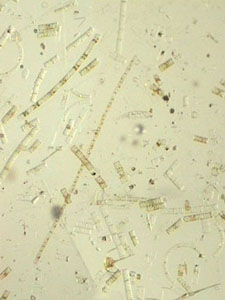
 |
|
Our Data...Organisms |
| Upwelling Zone |
|
|
Our
upwelling station at Georges Bank was thick with fog but we were able
to make out some seabirds and a whale spouting in the distance. |
 |
|
|
The upwelling station's net tow yielded a highly diverse, downright "soupy," assemblage. Chain diatoms, probably Guinardia, dominated the sample. One type of chain diatom was "curly" in form (below left). Another notable diatom was Coscinodiscus, which is shaped like a hockey puck (below right). We also saw a few pennate diatoms. |
 |
|
|
|
| The dinoflagellates most commonly seen in the upwelling station net tows were Ceratium. An unusual paired example is shown below. The "bow-shaped" organism at the upper left is another species of Ceratium. |
|
Veliger, "blob-like" larval bivalves, were also captured (below).
|
|
|
Radiolaria (left) are amoeboid zooplankton that are commonly found with phytoplankton. Below are two examples of copepods that graze on phytoplankton and small zooplankton. The Copepod at the right is an egg-bearing female.
|
|
A relatively large jelly is shown to the right. Another grazer, an arrow worm, was found at this station (below).
|
|
| Our slide-making revealed cool nanoplankton....
|
.....and some picoplankton too!
|
| . |